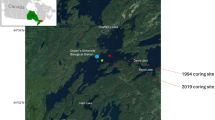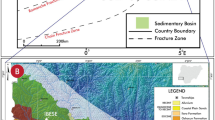Abstract
The hydrological history of a temporary pond in South Carolina was inferred from a 5500-year record of siliceous microfossils, including diatoms, freshwater sponge spicules, chrysophyte cysts, plates of testate amoebae and plant phytoliths. Microfossil abundance was estimated by microscopic quantification of siliceous particles and by chemical extractions of silica. Diatom, sponge and mineral particle volumes were correlated with silica concentrations attributable to these fractions. Both techniques suggested a sequence of four distinct community types. Basal sediments (4630–5520 14C YBP) containing phytoliths and sponge spicules indicative of a wetland community were covered by sediments dominated by the remains of planktonic protists (3750–4630 14C YBP) suggesting a transition from a vegetated marsh to an open-water, permanently flooded pond. Microfossil assemblages above this zone indicate the return of a wetland community ca. 3750 YBP that persisted until recently, when pond water levels stabilized as a result of seepage from a reservoir constructed nearby in 1985. This study suggests that the suite of siliceous microfossils commonly found in pond sediments can be used to infer historical alternations between macrophyte and plankton-dominated states in shallow basins. Regional climate inferences from this record include a mid-Holocene hydrological maximum and the onset of the modern climate ca. 3500 YBP.
Similar content being viewed by others
References
Bachmann R.W., Hoyer M.V. and Canfield D.E. Jr. 2000. Internal heterotrophy following the switch from macrophytes to algae in Lake Apopka, Florida. Hydrobiologia 418: 217–227.
Bachmann R.W., Hoyer M.V. and Canfield D.E. Jr. 2001. Evaluation of recent limnological changes at Lake Apopka. Hydrobiologia 448: 19–26.
Battarbee R.W. 1973. A new method for estimating absolute microfossil numbers with special reference to diatoms. Limnol. Oceanogr. 18: 647–653.
Battarbee R.W., Carvalho L., Jones V.J., Flower R.J., Cameron N.G., Bennion H. and Juggins S. 2001. Diatoms. In: Smol J.P., Birks H.J.B. and Last W.M. (eds), Tracking Environmental Change Using Lake Sediments. Vol. 3: Terrestrial, Algal, and Siliceous Indicators, Kluwer Academic Publishers, Dordrecht, pp. 155–202.
Blindow I., Andersson G., Hargeby A. and Johansson S. 1993. Long-term pattern of alternative stable states in two shallow eutrophic lakes. Freshwat. Biol. 30: 159–167.
Binford M.W. 1990. Calculation and uncertainty analysis of 210Pb dates for PIRLA project lake sediment cores. J. Paleolim. 3: 253–267.
Brooks M.J., Stone P.A., Colquhoun D.J. and Brown J.G. 1989. Sea level change, estuarine development and temporal variability in Woodland period subsistence settlement patterning on the lower coastal plain of South Carolina. In: Goodyear A.C. and Hanson G.T. (eds), Studies in South Carolina Archaeology in Honor of Robert L. Stephenson. Anthropological Studies 9, South Carolina Institute of Archaeology and Anthropology, University of South Carolina, Columbia, SC, pp.91–100.
Brooks M.J. and Sassaman K.E. 1990. Point bar geoarchaeology in the upper coastal plain of the Savannah River valley, South Carolina. A case study. In: Lasca N.P. and Donohue J.E. (eds), Archaeological Geology of North America, Geological Society of America, Centennial Special Vol. 4, pp. 183–197.
Colquhoun D.J., Brooks M.J. and Stone P.A. 1995. Sea-level fluctuation: emphasis on temporal correlations with records from areas with strong hydrologic influences in the southeastern United States. J. Coastal Res. 17: 191–196.
Conley D.J. 1988. Biogenic silica as an estimate of siliceous microfossil abundance in Great Lakes sediments. Biogeochemistry 6: 161–179.
Conley D.J., Kilham S.S. and Theriot E. 1989. Differences in silica content between marine and freshwater diatoms. Limnol. Oceanogr. 34: 205–213.
Conley D.J. and Schelske C.L. 1993. Potential role of sponge spicules in influencing the silicon biogeochemistry of Florida lakes. Can. J. Fish. Aquat. Sci. 50: 296–302.
Conley D.J. and Schelske C.L. 2001. Biogenic silica. In: Smol J.P., Birks H.J.B. and Last W.M. (eds), Tracking Environmental Change Using Lake Sediments. Vol. 3: Terrestrial, Algal, and Siliceous Indicators, Kluwer Academic Publishers, Dordrecht, pp. 281–293.
Dean W.E. 1974. Determination of carbonate and organic matter in calcareous sediments and sedimentary rocks by loss on ignition: comparison with other methods. J. Sed. Petrol. 44: 242–248.
Delcourt P.A. and Delcourt H.R. 1984. Late Quaternary paleoclimates and biotic responses in eastern North America and the western North Atlantic ocean. Palaeogeogr. Palaeoclim. Palaeoecol. 48: 263–284.
Douglas M.S.V. and Smol J.P. 2001. Siliceous protozoan plates and scales. In: Smol J.P., Birks H.J.B. and Last W.M. (eds), Tracking Environmental Change Using Lake Sediments. Vol. 3: Terrestrial, Algal, and Siliceous Indicators, Kluwer Academic Publishers, Dordrecht, pp. 265–279.
Engstrom D.R. and Wright H.E. Jr. 1984. Chemical stratigraphy of lake sediments as a record of environmental change. In: Haworth E.Y. and Lund J.W.G. (eds), Lake Sediments and Environmental History, University of Minnesota Press, Minneapolis, pp. 11–68.
Flower R.J. 1980. A study of sediment formation, transport and deposition in Lough Neagh, Northern Ireland, with special reference to diatoms. Ph.D. dissertation, New University of Ulster.
Frey D.G. 1953. Regional aspects of the late-glacial and post-glacial pollen succession of southeastern North America. Ecol. Monogr. 23: 289–313.
Fritz S.C., Cumming B.F., Gasse F. and Laird K.R. 1999. Diatoms as indicators of hydrologic and climate change in saline lakes. In: Stoermer E.F. and Smol J.P. (eds), The Diatoms: Applications for the Environmental and Earth Sciences, Cambridge University Press, Cambridge, pp. 41–72.
Frost T.M. 2001. Freshwater sponges. In: Smol J.P., Birks H.J.B. and Last W.M. (eds), Tracking Environmental Change Using Lake Sediments. Vol. 3: Terrestrial, Algal, and Siliceous Indicators, Kluwer Academic Publishers, Dordrecht, pp. 253–263.
Gaiser E.E. and Johansen J. 2000. Freshwater diatoms from Carolina bays and other isolated wetlands on the Atlantic Coastal Plain of South Carolina, USA, with a description of seven taxa new to science. Diatom Res. 15: 75–130.
Gaiser E.E., Taylor B.E. and Brooks M.J. 2001. Establishment of wetlands on the southeastern Atlantic Coastal Plain: paleolimnological evidence of a mid-Holocene hydrologic threshold from a South Carolina pond. J. Paleolim. 26: 373–391.
Gleason P.J. and Stone P.A. 1994. Age, origin and landscape evolution of the Everglades peatland. In: Davis S. and Ogden J. (eds), Everglades: The Ecosystem and its Restoration, St. Lucie Press, Delray Beach, pp. 149–197.
Heiri O., Lotter A.F. and Lemcke G. 2001. Loss on ignition as a method for estimating organic and carbonate content in sediments: reproducibility and comparability of results. J. Paleolim. 25: 101–110.
Kenney W.F., Waters M.N., Schelske C.L. and Brenner M. 2002. Sediment records of phosphorus-driven shifts to phytoplankton dominance in shallow Florida lakes. J. Paleolim. 27: 367–377.
Kingston J.C. 1982. Association and distribution of common diatoms in surface samples from northern Minnesota peatlands. Nova Hedwigia Beih. 73: 333–346.
Krausse G.L., Schelske C.L. and Davis C.O. 1983. Comparison of three wet alkaline methods of digestion of biogenic silica in water. Freshwat. Biol. 13: 73–81.
Lide R.F. 1997. When is a depression wetland a Carolina bay?. Southeast. Geogr. 36: 90–98.
Mullin M.M., Sloan P.R. and Eppley R.W. 1966. Relationship between carbon content, cell volume and area in phytoplankton. Limnol. Oceanogr. 11: 307–311.
Peinerud E.K., Ingri J. and Ponter C. 2001. Non-detrital Si concentrations as an estimate of diatom concentrations in lake sediments and suspended material. Chem. Geol. 177: 229–239.
Piperno D.R. 2001. Phytoliths. In: Smol J.P., Birks H.J.B. and Last W.M. (eds), Tracking Environmental Change Using Lake Sediments. Vol. 3: Terrestrial, Algal, and Siliceous Indicators, Kluwer Academic Publishers, Dordrecht, pp. 235–251.
Prebble M., Schallenberg M., Carter J. and Shulmeister J. 2002. An analysis of phytolith assemblages for the quantitative reconstruction of late Quaternary environments of the Lower Taieri Plain, Otago, South Island, New Zealand I. Modern assemblages and transfer functions. J. Paleolim. 27: 393–413.
Prebble M. and Shulmeister J. 2002. An analysis of phytolith assemblages for the quantitative reconstruction of late Quaternary environments of the Lower Taieri Plain, Otago, South Island, New Zealand II. Paleoenvironmental reconstruction. J. Paleolim. 27: 415–427.
Renberg I. 1976. Palaeolimnological investigations in Lake Prästsjö n. Early Norrland 9: 113–159.
Schalles J.F., Sharitz R.R., Gibbons J.W., Leversee G.J. and Knox J.N. 1989. Carolina Bays of the Savannah River Plant, Aiken, South Carolina. Savannah River Ecology Laboratory, Aiken, SC, USA, 70 pp.
Scheffer M., Hosper S.H., Meijer M.L., Moss B. and Jeppesen E. 1993. Alternative equilibria in shallow lakes. Trends Ecol. Evol. 8: 275–279.
Schelske C.L., Donar C.M. and Stoermer E.F. 1999. A test of paleolimnologic proxies for the planktonic/benthic ratio of microfossil diatoms in Lake Apopka. In: Mayama S., Idei M. and Kizumi I. (eds), 14th Diatom Symposium, Koeltz Scientific Books, Koenigstein, pp. 376–382.
Schelske C.L., Aldridge F.J., Carrick H.J. and Coveney M.F. 2003. Phytoplankton community photosynthesis and primary production in a hypereutrophic lake, Lake Apopka, Florida. Arch. Hydrobiol. 157: 145–172.
Scherer R.P. and Cohen A.D. 1984. Diatoms in Okefenokee Swamp peats. In: Andrejko Cohen A.D. (eds), The Okefenokee Swamp: Its Natural History, Geology and Geochemistry, Wetlands Surveys, Los Alamos, NM, pp. 456–467.
Sharitz R.R. and Gresham C.A. 1997. Pocosins and Carolina bays. In: Messina M.G. and Conner W.H. (eds), Southern Forested Wetlands: Ecology and Management, CRC/Lewis Publishers, Boca Raton, FL, pp. 343–377.
Shumate B.C., Schelske C.L., Crisman T.L. and Kenney W.F. 2002. Response of the cladoceran community to trophic state change in Lake Apopka, Florida. J. Paleolim. 27: 71–77.
Sicko-Goad L.M., Schelske C.L. and Stoermer E.F. 1984. Estimation of intracellular carbon and silica content of diatoms from natural assemblages using morphometric techniques. Limnol. Oceanogr. 29: 1170–1178.
Spackman W., Cohen A.D., Given P.H. and Casagrande D.J. 1976. A field guidebook to aid in the comparative study of the Okefenokee Swamp and the Everglades mangrove swamp marsh complex of southern Florida Coal Research Section. The Pennsylvania State University, 403 pp.
Stoermer E.F., Andresen N.A. and Schelske C.L. 1992. Diatom succession in the recent sediments of Lake Okeechobee, Florida, USA. Diatom Res. 7: 367–386.
Stone P.A. and Gleason P.J. 1983. Environmental and paleoenvironmental significance of organic sediments (peats) in southeastern United States. In: Colquhoun D.J. (ed.), Variation in Sea Level on the South Carolina Coastal Plain, Department of Geology, University of South Carolina, Columbia, pp. 121–141.
Watts W.A. 1980. Late Quaternary vegetation history of White Pond on the inner coastal plain of South Carolina. Quat. Res. 13: 187–199.
Watts W.A. and Hansen B.C.S. 1988. Environments of Florida in the Late Wisconsin and Holocene. In: Purdy B.A. (ed.), Wet Site Archeology, Telford Press, Cladwell, NJ, pp. 307–323.
Watts W.A., Grimm E.C. and Hussey T.C. 1996. Mid-Holocene forest history of Florida and the coastal plain of Georgia and South Carolina. In: Sassaman K.E. and Anderson D.G. (eds), Archaeology of the mid-Holocene Southeast, University Press of Florida, Gainesville, Florida, USA, pp. 28–40.
Whitehead D.R. 1965. Palynology and Pleistocene phytogeography of unglaciated eastern North America. In: Wright W.E. Jr. and Frey D.G. (eds), The Quaternary of the United States. Princeton University Press, Princeton, pp. 417–432.
Whitehead D.R. 1981. Late-Pleistocene vegetational changes in northeastern North Carolina. Ecol. Monogr. 51: 451–471.
Wujek D.E. 2000. Identification, ecology, and distribution of silica-scale bearing chrysophytes from the Carolinas. I. Piedmont region. J. Elisha Mitchell Sci. Soc. 116: 307–323.
Zeeb B.A. and Smol J.P. 2001. Chrysophyte scales and cysts. In: Smol J.P., Birks H.J.B. and Last W.M. (eds), Tracking Environmental Change Using Lake Sediments. Vol. 3: Terrestrial, Algal, and Siliceous Indicators, Kluwer Academic Publishers, Dordrecht, pp. 203–223.
Author information
Authors and Affiliations
Rights and permissions
About this article
Cite this article
Gaiser, E.E., Brooks, M.J., Kenney, W.F. et al. Interpreting the hydrological history of a temporary pond from chemical and microscopic characterization of siliceous microfossils. Journal of Paleolimnology 31, 63–76 (2004). https://doi.org/10.1023/B:JOPL.0000013280.72275.81
Issue Date:
DOI: https://doi.org/10.1023/B:JOPL.0000013280.72275.81




